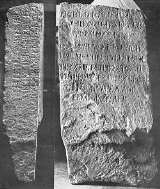
Kensington Runestone
Overview
The Kensington Runestone is a 200-pound slab of greywacke
covered in runes
on its face and side which, if genuine, would suggest that Scandinavia
n explorers reached the middle of North America
in the 14th century. It was found in 1898 in the largely rural township of Solem, Douglas County
, Minnesota
, and named after the nearest settlement, Kensington
. Almost all Runologists
and experts in Scandinavian linguistics
consider the runestone to be a hoax
. The runestone has been analyzed and dismissed repeatedly without local effect.
Greywacke
Greywacke or Graywacke is a variety of sandstone generally characterized by its hardness, dark color, and poorly sorted angular grains of quartz, feldspar, and small rock fragments or lithic fragments set in a compact, clay-fine matrix. It is a texturally immature sedimentary rock generally found...
covered in runes
Runic alphabet
The runic alphabets are a set of related alphabets using letters known as runes to write various Germanic languages before the adoption of the Latin alphabet and for specialized purposes thereafter...
on its face and side which, if genuine, would suggest that Scandinavia
Scandinavia
Scandinavia is a cultural, historical and ethno-linguistic region in northern Europe that includes the three kingdoms of Denmark, Norway and Sweden, characterized by their common ethno-cultural heritage and language. Modern Norway and Sweden proper are situated on the Scandinavian Peninsula,...
n explorers reached the middle of North America
North America
North America is a continent wholly within the Northern Hemisphere and almost wholly within the Western Hemisphere. It is also considered a northern subcontinent of the Americas...
in the 14th century. It was found in 1898 in the largely rural township of Solem, Douglas County
Douglas County, Minnesota
As of the census of 2000, there were 32,821 people, 13,276 households, and 9,027 families residing in the county. The population density was 52 people per square mile . There were 16,694 housing units at an average density of 26 per square mile...
, Minnesota
Minnesota
Minnesota is a U.S. state located in the Midwestern United States. The twelfth largest state of the U.S., it is the twenty-first most populous, with 5.3 million residents. Minnesota was carved out of the eastern half of the Minnesota Territory and admitted to the Union as the thirty-second state...
, and named after the nearest settlement, Kensington
Kensington, Minnesota
Kensington is a city in Douglas County, Minnesota, United States. The population was 292 at the 2010 census. The city is notable in Minnesota history for being the place where the famous, if questionable, Kensington Runestone was first displayed. The stone tablet may indicate that Scandinavians...
. Almost all Runologists
Runology
Runology is the study of the Runic alphabets, Runic inscriptions and their history. Runology forms a specialized branch of Germanic linguistics.-History:...
and experts in Scandinavian linguistics
Linguistics
Linguistics is the scientific study of human language. Linguistics can be broadly broken into three categories or subfields of study: language form, language meaning, and language in context....
consider the runestone to be a hoax
Hoax
A hoax is a deliberately fabricated falsehood made to masquerade as truth. It is distinguishable from errors in observation or judgment, or rumors, urban legends, pseudosciences or April Fools' Day events that are passed along in good faith by believers or as jokes.-Definition:The British...
. The runestone has been analyzed and dismissed repeatedly without local effect.
Unanswered Questions

